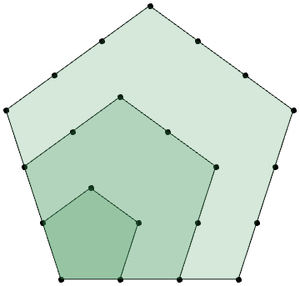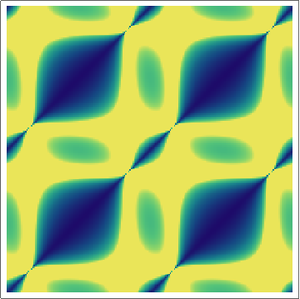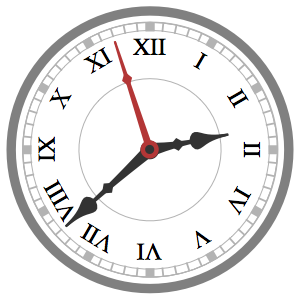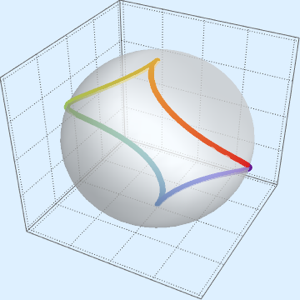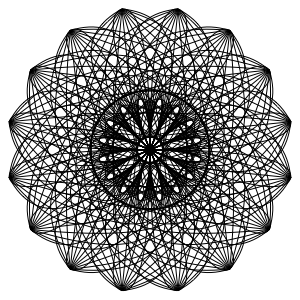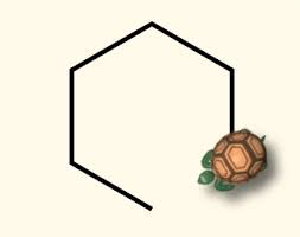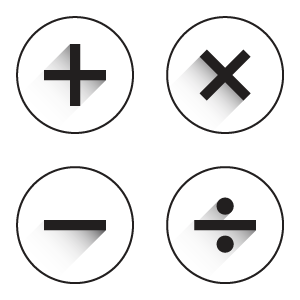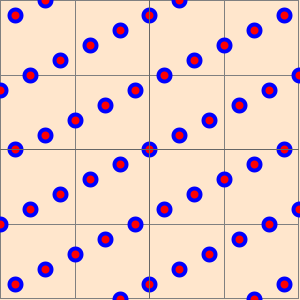Résolvez des problèmes combinatoires à l'aide de Permanent
Un permanent est semblable à un déterminant, sauf que tous les termes ont un signe positif.
In[1]:=
Permanent[\!\(\*
TagBox[
RowBox[{"(", "", GridBox[{
{
SubscriptBox["a",
RowBox[{"1", ",", "1"}]],
SubscriptBox["a",
RowBox[{"1", ",", "2"}]]},
{
SubscriptBox["a",
RowBox[{"2", ",", "1"}]],
SubscriptBox["a",
RowBox[{"2", ",", "2"}]]}
},
GridBoxAlignment->{
"Columns" -> {{Left}}, "ColumnsIndexed" -> {},
"Rows" -> {{Baseline}}, "RowsIndexed" -> {}, "Items" -> {},
"ItemsIndexed" -> {}},
GridBoxSpacings->{"Columns" -> {
Offset[0.27999999999999997`], {
Offset[0.7]},
Offset[0.27999999999999997`]}, "ColumnsIndexed" -> {}, "Rows" -> {
Offset[0.2], {
Offset[0.4]},
Offset[0.2]}, "RowsIndexed" -> {}, "Items" -> {},
"ItemsIndexed" -> {}}], "", ")"}],
Function[BoxForm`e$,
MatrixForm[BoxForm`e$]]]\)]Out[1]=
In[2]:=

Permanent[\!\(\*
TagBox[
RowBox[{"(", "", GridBox[{
{
SubscriptBox["a",
RowBox[{"1", ",", "1"}]],
SubscriptBox["a",
RowBox[{"1", ",", "2"}]],
SubscriptBox["a",
RowBox[{"1", ",", "3"}]]},
{
SubscriptBox["a",
RowBox[{"2", ",", "1"}]],
SubscriptBox["a",
RowBox[{"2", ",", "2"}]],
SubscriptBox["a",
RowBox[{"2", ",", "3"}]]},
{
SubscriptBox["a",
RowBox[{"3", ",", "1"}]],
SubscriptBox["a",
RowBox[{"3", ",", "2"}]],
SubscriptBox["a",
RowBox[{"3", ",", "3"}]]}
},
GridBoxAlignment->{
"Columns" -> {{Left}}, "ColumnsIndexed" -> {},
"Rows" -> {{Baseline}}, "RowsIndexed" -> {}, "Items" -> {},
"ItemsIndexed" -> {}},
GridBoxSpacings->{"Columns" -> {
Offset[0.27999999999999997`], {
Offset[0.7]},
Offset[0.27999999999999997`]}, "ColumnsIndexed" -> {}, "Rows" -> {
Offset[0.2], {
Offset[0.4]},
Offset[0.2]}, "RowsIndexed" -> {}, "Items" -> {},
"ItemsIndexed" -> {}}], "", ")"}],
Function[BoxForm`e$,
MatrixForm[BoxForm`e$]]]\)]Out[2]=
Ainsi, l'application de Permanent à une matrice dont les entrées sont égales à 1 est un moyen amusant mais inefficace de calculer la fonction factorielle.
In[3]:=
Table[Permanent[ConstantArray[1, {n, n}]], {n, 10}]Out[3]=
Le permanent peut être utilisé pour résoudre le problème combinatoire le plus intéressant suivant : étant donné  ensembles, chacun contenant un sous-ensemble de
ensembles, chacun contenant un sous-ensemble de  , combien de façons y a-t-il de choisir un élément distinct de chaque sous-ensemble ? Tout d'abord, construisez la matrice
, combien de façons y a-t-il de choisir un élément distinct de chaque sous-ensemble ? Tout d'abord, construisez la matrice  où la position
où la position  contient un 1 quand le sous-ensemble
contient un 1 quand le sous-ensemble  contient
contient  , et zéro dans le cas contraire.
, et zéro dans le cas contraire.
In[4]:=
sets = {{3, 5, 6, 7}, {3, 7}, {1, 2, 4, 5, 7}, {3}, {1, 3, 6}, {1, 5,
7}, {1, 2, 3, 6}}Out[4]=
In[5]:=
m = Table[If[MemberQ[sets[[i]], j], 1, 0] , {i, 7}, {j, 7}];
m // MatrixFormOut[5]//MatrixForm=
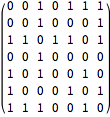
Le permanent de  est la solution au problème.
est la solution au problème.
In[6]:=
Permanent[m]Out[6]=
Confirmez la réponse en construisant explicitement tous les tuples.
In[7]:=
Select[Tuples[sets], DuplicateFreeQ]Out[7]=

